Ijraset Journal For Research in Applied Science and Engineering Technology
- Home / Ijraset
- On This Page
- Abstract
- Introduction
- Conclusion
- References
- Copyright
Enhancing Tourism Potential of Ramtek Town, Maharashtra
Authors: Ar. Niharika Patil, Prof. Ar. Ankita Agrawal, Prof. Ar. Kuldeep K Bhatia
DOI Link: https://doi.org/10.22214/ijraset.2023.54575
Certificate: View Certificate
Abstract
Tourism is acknowledged to be important for development due to its various factots encompassing economic, social, political, environmental, cultural and psychological characteristics . It is also recognized as one of the world’s largest industries, contributing 10% to the global GDP, with enormous potential for further growth. In many countries, especially in the developing countries, tourism has become a major source of foreign exchange earnings emphasizing the need for concentrated and sustained efforts towards its development. . Tourism industry in Maharashtra has a tremendous potential for growth, given the availability of basic infrastructure and the variety of tourist themes offered by various destinations in Maharashtra. Maharashtra has a rich historical and cultural heritage, which has been under-explored by the tourism industry and the government agencies. we are trying to focus one such Pilgrimage Tourist Place “Ramtek” in Maharashtra. Primarily it is a pilgrimage centre also known as kashi of vidarbha for the existence of Ambala lake which is considered as ganga.Ramtek town observes the yatra three times a year during period of Dashahara, Kartik Poornima and shriramnavmi which attracts the people from all-around the region to enjoy the same. The number of pilgrims coming to visit yatra was around one lakh at some time,nowadays reduce in thousands. Ramtek pilgrimage is seen under different religions like Jainism, Hindus and Muslims. The water bodies in the form of lakes, baolis(stepped wells) are the part of rituals. Some of these are also termed as ‘Ganga’, holy water hence deity is placed inside it. Agasthi aashram at ramgiri has got its historical and religious importance in Ramtek.This dissertation is slimly based on to enhance the tourism potential of the ramtek and due to this it could be help in growth of town and also could have job opportunities for the people living in the ramtek town and also we will enhance the existing tourism spots with coordination of religious and leisure tourism.
Introduction
I. INTRODUCTION
‘Ramtek’, in Maharashtra bounded by Ramgiri hill, Kaikai hill and several lakes, the city stands for its importance of cultural and religious beliefs and values. Ramtek gained importance due to Ram Mandir which is situated at the crown of Ramgiri hill. The growth of the town, location of important architectural, cultural, religious landmarks and street network has been dictated by the form and presence of several hills and lakes, and Ramagiri hills form the most dominant feature of the landscape. The growth of the town, location of important architectural, cultural, religious landmarks and street network has been dictated by the form and presence of several hills and lakes, and Ramagiri hills form the most dominant feature of the landscape. People have a great belief in the sanctity of the place. Pilgrims come here to bathe in the tank on the day of Chaitra Purnima and Ramnavami when a fair is held. The fair is attended by about 6,000 people coming around. Looking at the rituals performed, this place is of cultural importance. The temple complex needs to be preserved for the pilgrims. The associated Cultural landscape of Ramtek is rich with religious associations, rituals, meanings and places associated with mythological and past events, people, and their history of evolution.

A. Mythological Belifs
- There are many mythological beliefs attached to the place, it is believed that during the exile period Lord Rama, Sita and Lakshman came at Ramagiri hills to meet sage Agastya and killed a demon Sambasur and completed his rites at Ambala tank.
- It is also believed that Lord Hanuman while carrying Dronagiri mountain accidentally dropped a piece and thus, Ramtek has lots of medicinal species.
- Poet Kalidasa wrote ‘Meghaduta’, his poetry in the hills of Ramtek. He described the beauty of the landscape of Ramtek hill in his poetry.
- King Amba’s leprosy was cured by the water of Ambala tank which is known as Kashi of Vidarbha. Then, King Ambarish built ghats and temples along the Ambala tank.
- Different temples were built along the tank in different eras. Ambala tank is considered to be the most sacred water source in Ramtek. This water body due to its mythological belief is housing many ritualistic processes such as Pind daan, Asthi visarjan, meditation, etc. It is believed that Lord Ram blessed the water of Ambala with the purity of The Ganges. Thus, people of Ambala bathe and drink this water to purify their body and soul. Due to the architectural richness of the temples around the Ambala tank ,this place is also very famous for tourist activities such as boating, photoshoots, etc. Ambala has proved to be a major tourist attraction due to its serenity and sacredness

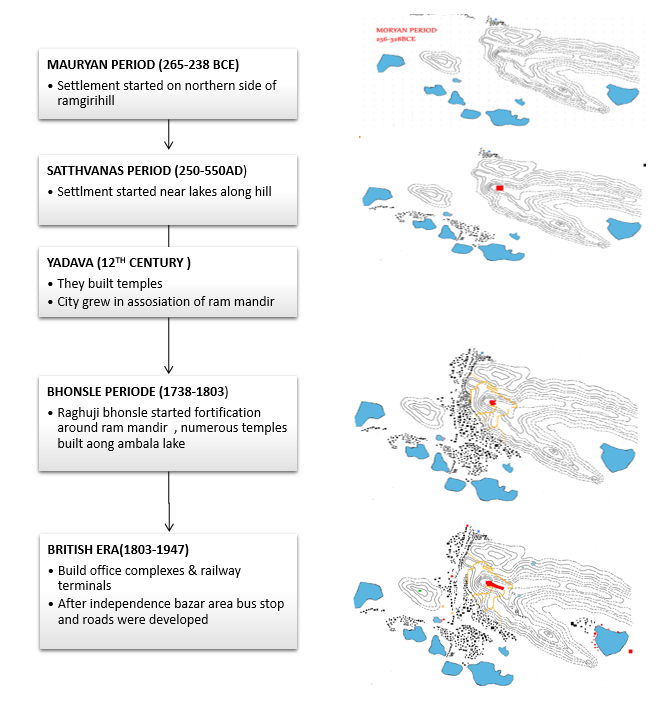
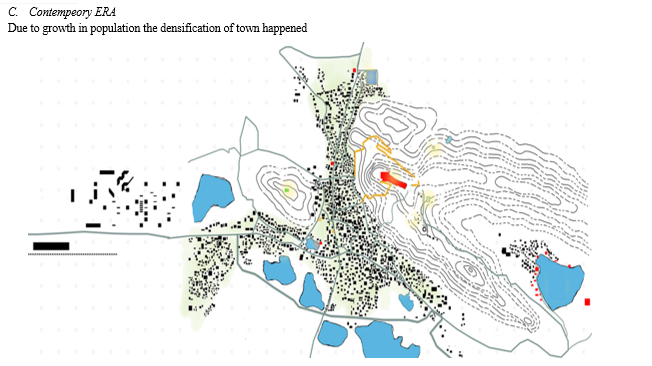
II. LITERATURE STUDY
A. Tourism
Tourism means experiencing a culture, location, language, cuisine and activities different than one’s own. Tourism has grown from the pursuit of the privileged few to mass movement of people with the urge to discover the unknown, to explore the new and strange places, to seek changes in environment and to undergo new experiences. It is a highly competitive business, dependent on many external factors over which a region or a destination has little or no control. Hence, it is often said that to satisfy tourist expectation within the constraints of a region or a destination and its environment will require both physical and human management strategies. The essence of management plans of tourist regions has to be the wise use of resources and harmonizing these with minimum conflict with the environment. Tourism started as a social phenomenon, but within a short span of time, has grown into a significant economic activity. As an economic activity, tourism is a business both for the individual entrepreneur and the community. It is based on the interrelated system of demand and supply factors. On the demand side are the international, national and local markets. The supply side involves the “tourism product” consisting of attractions, accessibility, facilities and infrastructure. It is an industry with great reliance on attraction and amenities, along with dependence on the goodwill of the local community. Therefore, the distribution of economic benefits has to be more wide spread than in the case of the traditional industry. The approach to tourism planning should move away from the narrow precincts of physical and promotional planning. It should facilitate the growth of tourism to a broader and more balanced approach, recognizing the needs and views of, not only, the tourists and developers but also the wider community. The strategic planning approach to tourism begins at much earlier stage than the determination of development strategy. It begins with an analysis of what has already been achieved, i.e., the critical assessment of various impacts, both positive and negative, of previous tourism development initiatives and an analysis of the political significance of tourism.
- World Wide Scenario
The Travel and Tourism (T&T) industry directly contributes about 3.6% of the world’s Gross Domestic Product (GDP) and indirectly contributes about 10.3% to it. As one of the biggest contributors to the global GDP, this industry directly employs nearly 77 million people worldwide, which comprises about 3% of the world’s total employment. The T&T industry also contributes to indirect employment generation to the tune of 234 million or 8.7 % of the total employment implying that one in every twelve jobs in the world is in the tourism industry. The industry also represents about 12% of the total world exports.
2. India Scenario
India’s share had been 0.8% of the world travel and tourism market. This share has risen from 0.6% in 2001. Despite the growing share of the Asian market, India’s total share in world tourist arrivals, however, remains a modest 0.8%, even though international arrivals to India have seen somewhat of a dramatic turnaround since 2002, when a temporary declining trend was reversed aggressively.
This turnaround was the result of several factors such as Government of India’s “Incredible India” campaign, high visibility afforded to India by its economic success, the tourism industry’s constant search for new destinations, and to some extent improvement in infrastructure in specific areas (such as better air connectivity of smaller and remote destinations). The total foreign tourist arrivals in India in 2005 was around 3.92 million, registering a CAGR of 18.1% over 2002-2005 vis-àvis world tourist arrivals which registered a growth of barely 4.76% on a larger base.
3. Maharshtra Scenario
Tourism industry in Maharashtra has a tremendous potential for growth, given the availability of basic infrastructure and the variety of tourist themes offered by various destinations in Maharashtra. Maharashtra has a rich historical and cultural heritage, which has been under-explored by the tourism industry and the government agencies.
The strong basic infrastructure availability throughout the state would provide a perfect platform for fresh private investments in development of tourism in the state, and in the process creating many direct and indirect employment opportunities to local residents.
Maharashtra had a total tourist arrivals of 9.37 million tourists of which 8.3 million were domestic and 1.07 million were foreign tourists. Maharashtra was ranked second for the foreign tourist arrivals in India accumulating a share of 17.72% close behind Delhi at 21.0%. In the domestic scenario Maharashtra accounted for only 3.95% of the arrivals in India and was ranked seventh. According to the Ministry of Tourism, Government of India, the total tourist arrivals in Maharashtra in the year 2001 was 93,72,327 (say 94 Lakh nos). With the growth rate of 6.72% per year to reach a figure of 344, 05,702 (say 344 Lakh nos.) in the year 2021.
4. Nagpur Division
Nagpur City has many distinctions. Popularly called the Orange City, it is the third largest city in Maharashtra. It is also the second greenest in India and is located at the very center of the heartland, almost equidistant from Kolkata, Chennai, New Delhi and Mumbai. Nagpur is a sprawling, seemingly infinite metropolis and is India's primary transport hub with all the nation's main Highways and railways intersecting there.
This city of wide, lush gardens and religious sites is culturally alive, and regularly hosts handicrafts exhibitions, tribal dances, and folkart programmes. Many festivals are celebrated here, including the Kalidas Mahotsav, the Ganesh Utsav and Dhamma Chakra Pravartan Din, Ramnavmi Shobhayatra and Marbat Utsav. Nagpur is one of the largest cities in central India and third largest in Maharashtra after Mumbai and Pune, with a district population of over 4. 6 million (as per Census 2011), it is the 9th largest urban agglomeration in India. Nagpur has historically been a major commercial and political center of Vidarbha Region and continues to be so even today.
Its location as the geographical center of the country is physically established by the Zero Mile Marker. This geographic significance of the city endows it with huge logistics related potential. With the increase in population in recent years, the city has expanded beyond its municipal boundaries. This rapid growth has seriously challenged the organized growth of the city and its fringes. This outgrowth needs to be better managed. Growth centers in the fringes of the city, such as MIHAN and other industrial estates
5. ramtek
Ramtek is one of those strategically located areas wherein diverse civilization and cultures met in past. The various hills – Kaikai hills, Ramgiri hills, Nagarjun hills, Hidimba hills covers the area. The Sur River and Kapila River flow through the region. This area was very much famous for its natural beauty and also its association with the lord Ram. It is believed that lord Ram had stayed in this area while in exile and took oath of killing demons here in agasthi ashram so it is termed as Ramtek. Due to this mythical association this area started developing as a pilgrimage centre tourism of ramtek is in religious purpose for to attract the tourist on basis of its strong mythological beliefs
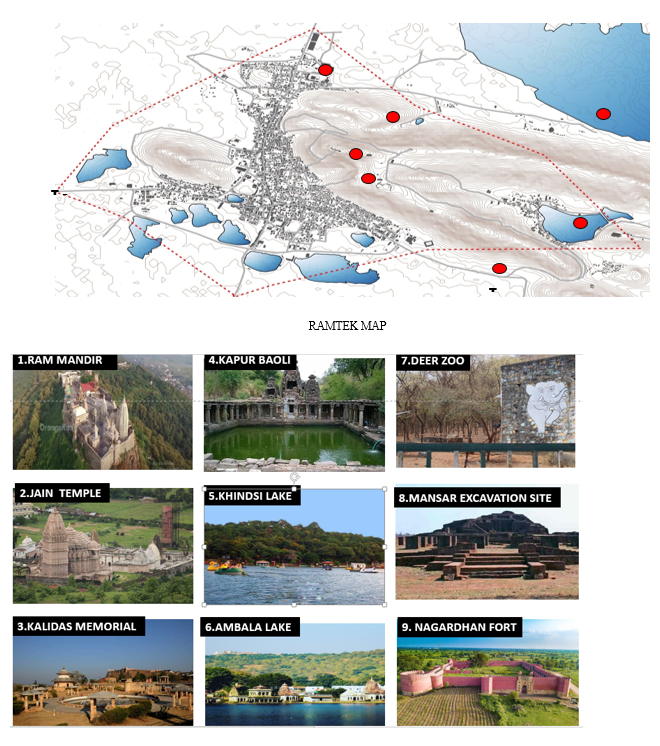
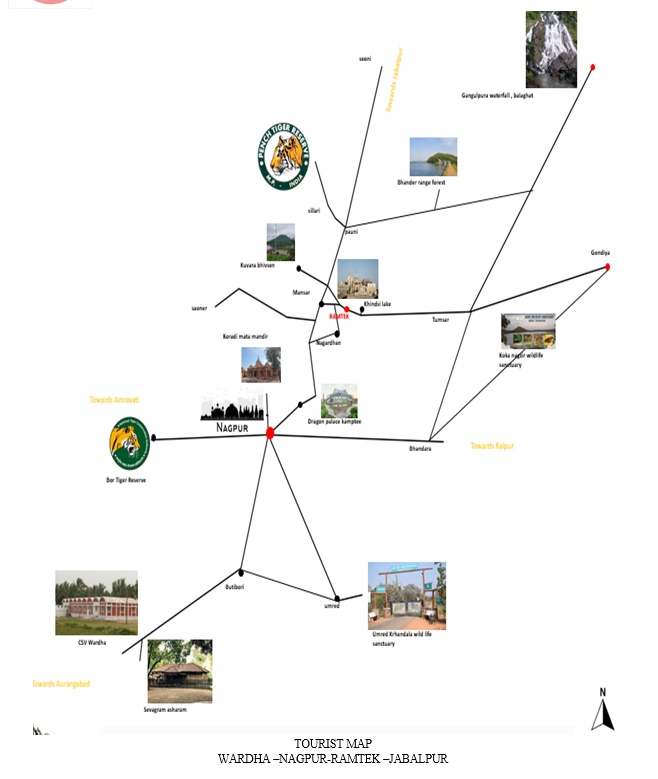

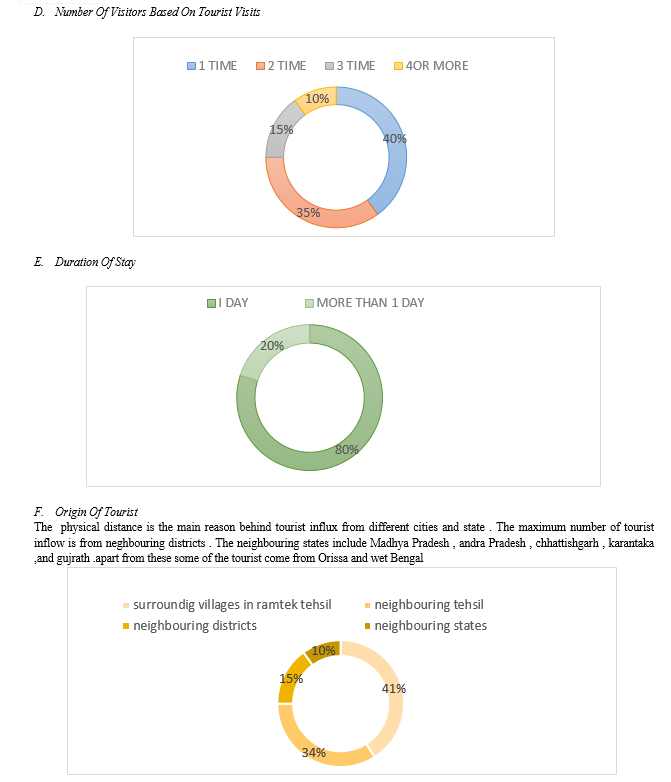
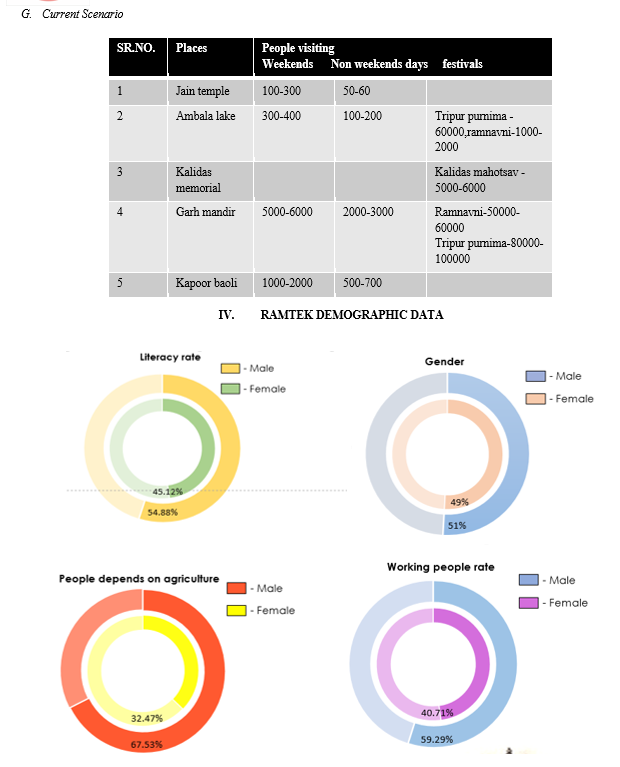
Conclusion
Ramtek is one of the growing town in vidharbha region for its rich historical significance and religious beliefs of people .ramtek as it is growing but also facing many drawbacks due to its very low economic development, as economic development of the society is very important as it helps the area to developed and create job opportunities for the people living in the town. so the major economy generation could be happened due to its tourism as tourism is one of the growing trend in today’s scenario it not only help tourist to know or visit different places but also helps people of various tourist places for its income provision for the people living in the area tourism is upmost priority for the under growing towns in India as it helps people of the town for their income provision . so one as the ramtek is lacking in its economic stability so to build ramtek as one of the tourist site which is already existing but for creating such a tourism influence in the site in corporation of religious and leisure tourism in ramtek town could influx in the tourist visit and so can create income provision for the town . Through provision of various activities or tourist places in the town and for the town people.
References
[1] Vaidya, C V , 2001. Epic India, Or, India as Described in the Mahabharata and the Ramayana. 1st ed. madras: Asian educational service Kalidasa\'s Meghdootam [2] Gram Panchayat data [3] Survey of India [4] Shodh bhagirathi, IITR- Ramtek tourism data, 2012 [5] Milind Ashok Kamble, Faiz Ahmed Chundeli, 2016,Visualizing the Structuring Principles of Sacred Urban Space – Ambala Tank, Ramtek [6] Post Graduation Thesis Report by Rajendra A. Dongre, SPA, N. Delhi, 1991on „Citizens Perception and Urban Planning, Case study: Ramtek, Nagpur District? [7] Mrs. Kalpana Kawathekar ( Thakare) , Prof A.J Sanyal 3Mrs. Anjali V. Narad (Bhasme) , Small Town Ramtek A Traditional Sustainable Community in India International Journal of scientific research and management (IJSRM) ,Volume4 Issue 08 [8] Study Report on Preparation of 20 Years Perspective Plan for Development of Sustainable Tourism in Maharashtra, 2003 [9] Anjali narad “Smart tourism ,a step towards sustainable development –a case of ramtek town Maharashtra “ Advances in Economics and Business Management (AEBM) Volume 6, Issue 3; April-June, 2019, pp. 149-156 [10] Puranik, A. Deshpande, and Y. Pawshe on ‘Unraveling Secrets:Ramtek model’, from ‘Making water everybody’s business, practice and policy of water harvesting’ edited by Anil Agarwal,Sunita Narain and Indira Khurana Centre for Science andEnvironment Report,2000, pg.no. 154 [11] Kalpana Kawathekar ( Thakare) and Anjali V. Narad (Bhasme)research paper “Small Town Ramtek A Traditional SustainableCommunity in India” published in International Journal ofscientific research and management (IJSRM)||Volume||4||Issue||08||Pages||4491-4496||2016|
Copyright
Copyright © 2023 Ar. Niharika Patil, Prof. Ar. Ankita Agrawal, Prof. Ar. Kuldeep K Bhatia. This is an open access article distributed under the Creative Commons Attribution License, which permits unrestricted use, distribution, and reproduction in any medium, provided the original work is properly cited.

Download Paper
Paper Id : IJRASET54575
Publish Date : 2023-07-01
ISSN : 2321-9653
Publisher Name : IJRASET
DOI Link : Click Here
 Submit Paper Online
Submit Paper Online

